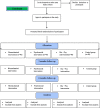Study protocol for a randomized controlled trial to improve the quality of life of housewives with musculoskeletal disorders: a health promotion intervention based on a participatory ergonomic approach-the Housewives Ergonomic Intervention (HEI) trial
- PMID: 34311747
- PMCID: PMC8314449
- DOI: 10.1186/s13063-021-05436-w
Study protocol for a randomized controlled trial to improve the quality of life of housewives with musculoskeletal disorders: a health promotion intervention based on a participatory ergonomic approach-the Housewives Ergonomic Intervention (HEI) trial
Abstract
Background: A variety of household chores expose women to a variety of biomechanical and psychosocial risk factors. A result of this is many housewives with musculoskeletal disorders. Given the interactive effects of these risk factors, it is necessary to consider multiple strategies to mitigate their effects. Accordingly, the present study will investigate the impact of a health promotion training program based on a participatory ergonomic approach towards a reduction in the prevalence of musculoskeletal disorders and an improvement in the quality of life of housewives.
Methods: Iranian housewives aged 20-65 years currently attending a specialist health clinic due to a painful musculoskeletal complaint will be invited to join the study. Recruitment will continue until a sample of 160 women provides informed consent to participate. The study will be conducted using a mixed-methods protocol in two phases. In the first phase, psychosocial and biomechanical risk factors will be identified using a qualitative approach. In the next phase, the results from the qualitative approach will be used to develop a conceptual framework based on health promotion theories and an intervention program based on a participatory ergonomic approach designed. Participants will be randomly allocated into one of four groups: (1) biomechanical intervention group, (2) psychosocial intervention group, (3) multidisciplinary intervention group (both biomechanical and psychosocial intervention), and (4) a control group. Data will be collected using Rapid Entire Body Assessment (REBA), Visual Analog Scale (VAS), Work Ability Score (WAS), Hospital Anxiety and Depression Scale (HADS), and the 36-item Short-Form health survey (SF-36) at baseline in 3-month and 6-month follow-up assessments. The impact of the three interventions on musculoskeletal disorders, work ability, stress, and quality of life will then be evaluated.
Discussion: The study will provide a practical approach to reducing stress, reducing musculoskeletal disorders, enhancing the ability to work, and improving the quality of life of women with musculoskeletal disorders associated with housework. If the designed interventions in the present study are effective, they will have the great practical potential for generalization to all housewives.
Trial registration: ClinicalTrials.gov IRCT20200602047640N . Registered on 07 September 2020 with the IRCTID.
Keywords: Ergonomics; Health promotional intervention; Housewives; Musculoskeletal disorders; Quality of life; Risk factors; Work-related stress.
© 2021. The Author(s).
Conflict of interest statement
The authors declare that they have no competing interests.
Figures
References
-
- Bernal D, Campos-Serna J, Tobias A, Vargas-Prada S, Benavides FG, Serra C. Work-related psychosocial risk factors and musculoskeletal disorders in hospital nurses and nursing aides: a systematic review and meta-analysis. Int J Nurs Stud. 2015;52:635–648. doi: 10.1016/j.ijnurstu.2014.11.003. - DOI - PubMed
-
- World Health Organization. International Classification of Functioning, Disability, and Health: ICF. Geneva: World Health Organization; 2001.
Publication types
MeSH terms
Grants and funding
LinkOut - more resources
Full Text Sources
Medical



